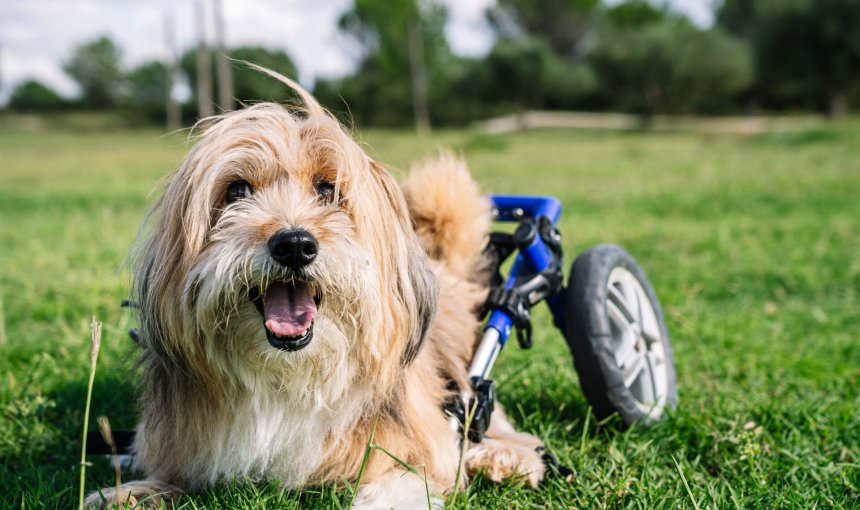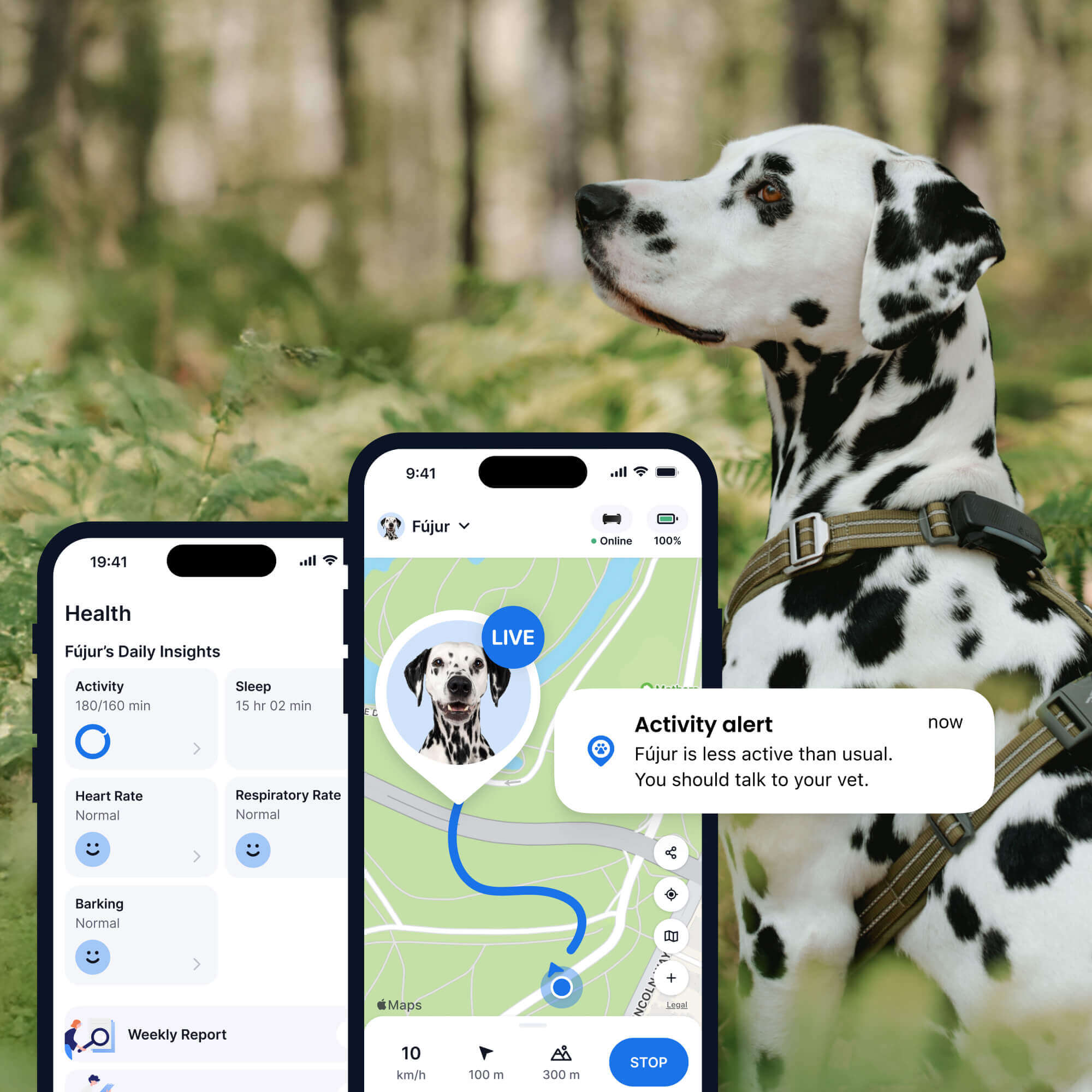 Approved by Dr. Dwight Alleyne, DVM
Approved by Dr. Dwight Alleyne, DVM Arthritis In Dogs: How To Catch & Handle It Early
It can be heartbreaking seeing your buddy no longer running or playing like before - but if you're dealing with a case of arthritis in dogs, it's important you catch it early. Here's how to spot it before it worsens - and how to handle it for good.

Does your buddy seem more reluctant around walks? Is it a chore to get them off their paws for a bit of playtime? If you’ve got a senior dog at home, watch out – it might not be them just growing “lazier” over time! Rather, you’re best off learning how to spot the signs of arthritis in dogs early on – and how to spot a drop in their activity – so you can help them live their happiest, healthiest life by your side.

Always know your buddy is healthy & safe
Read more- What is arthritis? And what causes it in dogs?
- Osteoarthritis vs Arthritis in dogs: What’s the difference?
- Where are joint problems in dogs most likely to turn up?
- How common is arthritis in dogs?
- What are the signs of arthritis in dogs ?
- How I can spot arthritis in dogs early?
- Dog arthritis treatment: What your vet might recommend
- How you can set up a supportive home environment for your dog
- How to catch on to arthritis early with an Activity Tracker
What is arthritis? And what causes it in dogs?
Osteoarthritis in dogs is a degenerative joint disease. Here, the cartilage that protects and supports your dog’s joints gradually breaks down with time and age. This degradation can lead to:
- Inflammation
- Pain
- Stiffness
- Limited mobility
- And in some rare cases, even joint deformities or bone damage
This condition can be a painful, scary condition to handle – but with some patience, vigilance, and lots of love, you can help your buddy live a long, happy, healthy life by your side. (Even in their grand-paw years.)
Osteoarthritis vs Arthritis in dogs: What’s the difference?
“Osteoarthritis” and “arthritis” are actually two different diseases, though the terms might be used interchangeably. Both affect your dog’s musculoskeletal system and can cause joint pain and dysfunction – though due to different causes.
| Osteoarthritis (or arthrosis) | Arthritis |
| Describes the gradual wear and tear of your dog’s joint cartilage over time. | Describes the inflammation of your dog’s joints. |
| May be caused by: – Ageing – Excessive stress on your dog’s joints – Genetic predisposition – Injury | May be caused by: – Autoimmune diseases, like rheumatoid arthritis – Infections, including from bacteria and viruses – Other medical conditions, like gout |
| Often causes arthritis | There are more than 100 different types of arthritis that can affect one or more joints. |
Where are joint problems in dogs most likely to turn up?
Much like humans, osteoarthritis in dogs might turn up in certain joints across their bodies. Though where it turns up can depend on your buddy’s breed, age, and activity level. Here are some of the most common spots you’ll find linked to joint problems in dogs:
- Hip joints, with hip dysplasia being a common hereditary condition that can lead to osteoarthritis in the hip joints.
- Stifle joints, or the joints near your dog’s hind legs.
- Elbow joints.
- Shoulder joints, especially among very active dogs.
- The spine, especially in older dogs.
- Toe joints, which can cause limping or difficulties walking.
Unfortunately, once your dog’s joints have been damaged by arthritis, it rarely repairs itself completely. But it’s possible to prevent their condition from worsening by keeping an eye out for your dog’s symptoms and risk factors, dropping by for regular checkups at your vet, and a combination of medical treatments and lifestyle adjustments.
How common is arthritis in dogs?
Sadly, arthritis in dogs is a pretty common condition – especially for senior dogs and those exposed to high levels of stress. But you might also find it occurring more often among:
- Large- and medium-sized dog breeds, like the Shepherd family, Great Danes, Newfoundlands, and Saint Bernards. In fact, German Shepherds have a genetic predisposition towards joint problems.2
- Dogs prone to weight gain, like in the Retriever family.
- Dogs with long backs, like Daschunds and Basset Hounds.
- Dogs with short legs and long bodies, like Corgis.
- Brachycephalic dog breeds, like Pugs, Bulldogs, and Boxers.
- Small dogs breeds, including miniature and toy breeds that might be more at risk for patellar luxation, or osteoarthritis of their stifle joints.
⚠️ Importantly: any dog of any breed can develop arthritis. And just having a dog of these breeds doesn’t necessarily mean they WILL develop arthritis.
What are the signs of arthritis in dogs?
Like with most age-related diseases, dog arthritis tends to develop slowly and gradually over time. So keep an eye out if you notice your buddy having:
- Trouble getting up and down from a lying position
- Slowness or stiffness when moving
- Difficulty climbing stairs or jumping into the car
- Joint swelling
- Excessive panting – especially after exercise
- Not seeming as keen to exercise as before
- Limping
- Frequently holding a leg off the ground
- Favoring one leg
- Seeming lethargic or less energetic in general
- Matted, tangled, less-groomed fur – since joint problems can make it difficult for your buddy to groom themselves in hard-to-reach spots
How I can spot arthritis in dogs early?
There’s a reason why vets recommend keeping track of your dog’s everyday movement. It’s a window into your dog’s overall health and wellbeing – and a change could signal that they might not be doing so well, health-wise.
“Keep track of your dog’s energy levels, especially how long they are able to walk.
If you notice significant declines, it could be a sign of pain, heart disease, or other illness.”
– VCA Animal Hospitals2
So start by watching out for these changes in your dog’s behavior – and remember: this isn’t your dog being “lazy” or “difficult” if they seem:
- Reluctant to go on walks
- Less interested in games that involve running or chasing – or they seem slower or tire out easier
- To sleep much more than usual
- Less sociable and more withdrawn, maybe even more aggressive
- Less curious or eager to explore the outdoors
- To pant or wheeze more after exercise – especially light exercise, like a walk
- To look for alternative routes around furniture, stairs, or any high objects
- To no longer eat as much food or drink as much water as usual
💡An Activity Tracker for dogs can help you catch on to a drop in your dog’s daily activity that much quicker – which could be a potential sign of sickness, injury, or pain. We’ll cover it in detail a little further below.

Get health alerts for your dog
Our pups can’t always tell us if something’s wrong. But if their tracker detects unusual changes in their routine, you’ll get an alert, helping you catch potential issues early.
Dog arthritis treatment: What your vet might recommend
Since arthritis is a relatively common condition among older dogs, there are quite a few therapy options for it. Your vet might diagnose your buddy’s condition through an x-ray scan to examine your dog’s joints and identify any problem areas, plus a full physical examination to get a picture of your dog’s overall health.
Based on how severe your dog’s symptoms are, here are a couple of steps your vet might recommend:
- Medical treatment, including anti-inflammatory medication to reduce pain and inflammation, joint supplements to improve your dog’s joint health, physical therapy, or even surgery in more serious cases.
- Dietary changes to help your dog maintain a healthy weight, including portion control or even a calorie-restricted diet.
- Gentle exercise that’s easy on your dog’s joints, like swimming, slow walks on soft surfaces, low Cavaletti poles, balancing toys, or even stair stepping.
How you can set up a supportive home environment for your dog
- Put a carpet over hardwood floors to reduce any slipping or sliding that sometimes happen to older dogs or dogs with joint problems.
- Go for walks with dog booties that reduce some of the pressure from walking on hard surfaces. (Though they can work indoors as well.)
- Keep your dog warm and dry: Cold and damp conditions can aggravate arthritis. Consider investing in a padded dog bed and apply warm compresses to painful joints.
- Use ramps and stairs to help your buddy get around to any hard-to-reach spots they might once have jumped to reach.
- Place your dog’s food and water bowls on elevated surfaces so that they don’t have to bend over or strain their necks to reach them.
- Provide your dog plenty of shade and cool water during the warmer months. Excessive heat can actually worsen inflammation and can even lead to potentially fatal conditions, like heat stroke.
How to catch on to arthritis early with an Activity Tracker
Tracking your dog’s activity can be a lifesaver – especially as they recover and get back on their feet again. But it’s also an important early sign that can help you catch arthritis in dogs much before it has a chance to worsen.
Strapped to your dog’s collar, your trusty your trusty Tractive GPS doubles as an Activity and Sleep Tracker for dogs. Logging in your dog’s movements throughout the day as “ active minutes.” Which, with time, can help you figure out:
- How active your dog is on the regular
- Where your dog ranks on your community leaderboard – i.e., how active they are compared to other, similar dogs around the world
- If there’s a weird drop in your dog’s everyday active minutes – whether gradual or more extreme – which you can catch with a Health Alert.
💡So you can take action early, get your dog to a vet, make an informed decision based on actionable data – and potentially save your dog’s life while at it.
Your furry friend’s health and wellbeing means as much as to us as it does to you. So we’ve made it a priority to only share medically-relevant content on our blog. This post was checked, double-checked, and medically verified by Georgia-based vet, Dr. Dwight Alleyne.

Dr. Dwight Alleyne, DVM
Originally from Long Island, New York, Dr. Alleyne began his career at a no-kill animal shelter before becoming a licensed veterinary technician. He graduated from Cornell University Veterinary College in 2006 and completed an internship at Purdue University. Now practicing in Georgia, Dr. Alleyne specializes in soft tissue surgery and ultrasounds. He also writes pet health articles on his website, “The Animal Doctor Blog” (www.anmldrblog.com).




